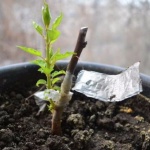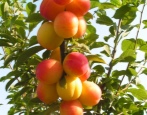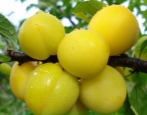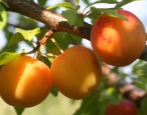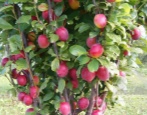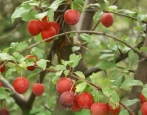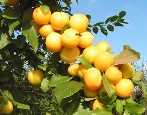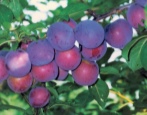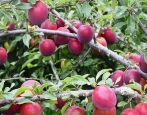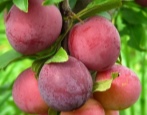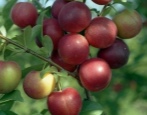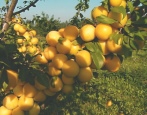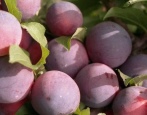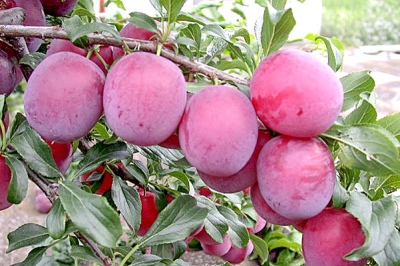
- Authors: A.V. Isachkin, N.V. Agafonov, B.N. Vorobiev, V.I.Susov (Moscow Agricultural Academy named after K.A.Timiryazev)
- Year of approval: 2004
- Growth type: medium-sized
- Ripening period: average
- Self-fertility: self-infertile
- Fruit size: large
- Yield: medium
- Appointment: universal
- Fruit weight, g: 37
- Fruit shape: rounded oval, aligned
Gardeners began to grow cherry plum on their plots not so long ago. When choosing a variety, most often preference is given to winter-hardy and unpretentious subspecies. This is precisely the variety that Cleopatra is.
Breeding history
A variety with such a beautiful name was included in the State Register of the Russian Federation in 2004. The plant was bred at the Moscow Agricultural Academy named after K.A.Timiryazev. The work was carried out under the leadership of A.V. Isachkin, N.V. Agafonov, B.N. and Susov V.I. A seedling obtained by free pollination of the Kuban comet culture was taken as a basis.
Description of the variety
Cleopatra is of medium height. The tree is not particularly tall, generally its height is 2.5-3 meters, in rare cases it reaches 4. The crown looks like a wide cone, its thickening is low. Shoots grow straight, they are thin, colored in a brown shade. The leaves are dark green, oval, their edge is large serrate, and the surface is smooth, with a beautiful glossy shine.
Fruit characteristics
The described variety is unique in that it produces large fruits of a spectacular dark red-violet color. The round-oval specimens weigh 37 grams. There is an abdominal suture, it is clearly visible.
The skin of the cherry plum is dense, of medium thickness. The peculiarity of the coating is a dense layer of gray wax plaque. The pulp is a little gristly, it is red in color. A medium-sized bone is separated with effort.
Taste qualities
The harvested crop of Cleopatra will have a sweet and sour taste. It is worth considering that the sun will have a direct effect on it. When grown in lighted areas, sugar will dominate in the fruits, and sourness if the tree is shaded. Cleopatra's taste was evaluated by experts. They gave him a rating of 4.7 points.
The cherry plum has a universal purpose. Most vitamins can be obtained in the case of fresh consumption, and for the winter the fruits are often frozen. And also compotes and jam are made from them, rolled into jars.
Ripening and fruiting
Cleopatra is a variety with medium early maturity. The first fruits from such trees are removed in the 4th year after planting. The flowering culture begins after mid-May, and the fruits ripen towards the end of summer, sometimes they can ripen by the beginning of autumn. Thus, the plant has an average ripening period.
Yield
Cherry plum of the described variety has an average yield. From a tree, you can get from 25 to 40 kilograms of fruit. They store well, so they will last a month or a month and a half. Fruiting at the tree is stable, and its lifespan is at least 45 years. There are also centenarians capable of producing crops up to 60 years.
Growing regions
Mostly Cleopatra is grown in the Central Region. However, it grows quietly in colder areas.
Self-fertility and the need for pollinators
The culture belongs to self-infertile subspecies, so pollinators are required without fail. For this, other varieties of plums and cherry plums with the same flowering periods are suitable. The varieties of the Chinese plum have proven themselves especially well.
Growing and care
Cherry plum Cleopatra is usually planted in sunny areas, devoid of nearby trees with large crowns. Plants are not afraid of groundwater close to the surface, because they love moisture. Gusty winds are undesirable, especially for young trees. The soil is selected black earth or sandy.Do not plant apples, pears or other stone fruits near Cleopatra.
In order for the plant to grow quickly, fertilizers are applied to the pit even at the stage of planting. Usually it is humus or compost, as well as mineral complexes. Acidic soils are lime. When planting, the soil is well rammed and watered, mulching will also be mandatory. The trees will need to be immediately tied to the pegs. The distance between seedlings is at least 3 meters.
It is not difficult to care for the planted plants. The focus is on the soil: emerging weeds are uprooted and the soil is often loosened to allow oxygen to flow in. Mulching can be continued in the following years of the tree's life, especially if the region is dry.
The culture is quite hygrophilous, moreover, it grows in the sun. In such conditions, the soil dries out quickly. Young, newly planted trees are watered at least 5 times per season, and even more often in severe drought. Mature trees will need a minimum of three waterings. At the same time, each plant is given about 20 liters of water per year of life. Watering Cleopatra should not be at the root, but with the help of grooves dug nearby. In October, the last water-charging irrigation is carried out.
They begin to feed the cherry plum in the second year. Once every few years, organic matter is introduced into the trunk circle, then the soil is dug up. Mineral fertilizers are given annually. Before flowering, it will be nitrogen, and in the first month of summer Cleopatra will need a phosphorus-potassium supplement. In May and June, leaf spraying is also carried out. For this, mineral complex compositions for stone fruits are used.
Sanitary pruning for Cleopatra is carried out in the spring. After winter, the tree is examined, branches that have been bruised by frost, as well as those that have dried out or are infected with a fungus, are removed. Formative pruning is usually carried out in the fall. Fresh shoots that have completed their growth are shortened by 0.2 m. They begin to rejuvenate the cherry plum by 10 years.
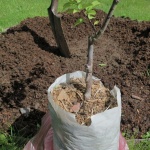
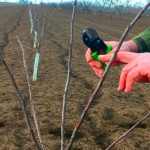
Disease and pest resistance
The variety has good immunity to the main diseases of stone fruits, but it is still not immune from diseases. May be affected by perforated spotting and moniliosis. Diseases may not appear if preventive treatment with fungicides is carried out in the spring and further proper care of the crop is carried out. It is very important to use sanitized garden tools as well.
Pest attacks are fought with both folk methods and potent insecticides. The main "invaders" are the plum moth, aphid, and the yellow plum sawfly. It is worth remembering that any insecticides are prohibited if harvest time is approaching.

Requirements for soil and climatic conditions
Cleopatra is very hardy. A particularly pleasant moment is that the buds do not freeze, even if the frost returns in the spring. Drought resistance of the culture is also high, so it is quite possible to cultivate it in an arid and hot climate.
